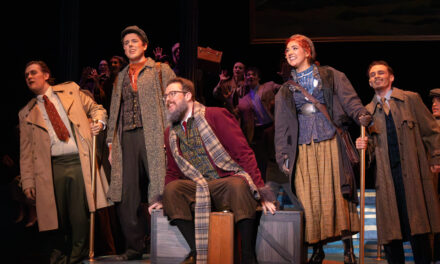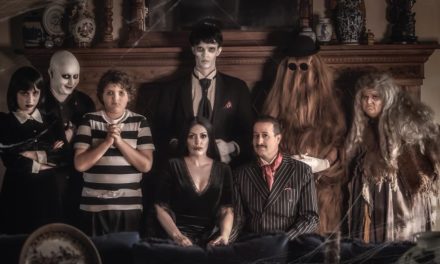SALT LAKE CITY — Even the title of In the Next Room or, The Vibrator Play gives us a hint that while you can expect to see a show about the advent and early medical uses of the vibrator. Although the vibrator itself is not the primary focus of the show, using humor and the absurdity of the subject, In the Next Room explores the emotional estrangements within relationships and how to use our hearts instead of machines to find happiness.
At the dawn of electricity, Dr. Givings (Joe Crnich) operates a medical practice from his home. He’s a respectable scientist and, like a child with a new toy, finds the invention of electricity to be a particularly stimulating (sorry) subject. He seems to have found a cure for hysteria (unmanageable emotions), which was primarily a women’s condition inflicting the womb, but had been known to affect a handful of men.
When Mr. Daldry (Michael Canham) brings his wife (Holly Fowers) to see Dr. Givings he explains that she has not been herself, is sensitive to light and that their intimacy has been lacking. Dr. Givings promptly identifies her condition and she is whisked away to be part of his experiment with modern electricity using a metal ball the size of a giant grapefruit attached to an elongated handle that “looks like a farming tool.” Mrs. Daldry is mousy and conservative, but obeys and allows the doctor to treat her with this machine. The result, as he calls it is a “paroxysm” or in other words, the releasing of pent of fluid from the womb and as Mrs. Daldry’s treatments continue the difference in her demeanor is remarkable.
Meanwhile, the doctor’s wife (Cassandra Stokes-Wylie) becomes increasingly interested and jealous of the noises she is hearing in the next room. As a woman in the late 1800’s, she is expected to be docile and complacent with her husband. Out of innocent truthfulness to herself, rather than rebellion, she blurts out whatever she has thinking and questions the actions of those around her readily.
Stokes-Wylie shines as Mrs. Givings. I found her genuine portrayal of an innocent yet curious woman to contrast beautifully with Crnich’s somewhat disengaged scientific approach to life. Crnich was just as stalwart in his portrayal of a scientific man earnestly trying to help those around him while being blind to the needs in his home. I loved his hesitation and thawing at the end of the show as he finally began to see his wife for who she really is. Stokes-Wylie was lively and engaging, even when she was angry with her husband. My favorite moments of the whole show were when she would say something improper and in an attempt to correct herself only end up getting herself in more trouble. Stokes-Wylie played these pieces with beautiful timing which made me even more of a fan of hers than I already am.
Fowers as the transformed Mrs. Daldry was charming and endearing. I especially loved the moments between her and Dr. Givings’s assistant Annie, played by Teresa Sanderson. The interactions between these two brought into stark contrast the lack of warmth and connection often found in Mrs. Daldry’s relationship with her husband. Though Canham brought a kind warmth and likeability to the character of Mr. Daldry, it was obvious that he was as ignorant as the rest of the men in this time period, which was best summed up by Dr. Givings when he said, “Men do not perceive because their intellect prevents them from seeing would fill a book.”
Jonathan Scott McBride as the unconventional artist carried himself with a relaxed yet electric energy that I found to be particularly engaging for his character. Michele Patrick as the Givings’s wet nurse Elizabeth was especially delightful when she revealed, to the shock of Mrs. Givings and Daldry, that women could get the same kind of pleasure from the machine as their husbands.
The lighting (Jesse Portillo) design was crisp and enhanced the differences between the warm room where Mrs. Givings spent most of her time and the cold medical room occupied by Mr. Givings. In addition, the set design clearly used the same colors to contrast the differences in these characters personalities. The set design (John Cook and Mike Sanchez) and costumes (Teresa Sanderson and Michael Nielson) were brilliantly done. I loved the use of costumes showing Mrs. Daldry’s transformation and in general the authenticity and quality of the clothing. The set and design elements were obviously considered important and I appreciated being transported to the Victorian Era. I especially got a kick out of the genuine sewing machine.
And last but not least the direction by Fran Pruyn was beautifully displayed in the excellent use of space, movement and pacing. I feel that the first act was a little slow, but this may have been more of a problem with the script which was written by Sarah Ruhl. Shortly into the second act the pace picked up and I was carried along the rest of the evening. In the Next Room or, the Vibrator Play with Pygmalion Productions is a gratifying and highly entertaining show. Unfortunately, it has already closed so you won’t have the opportunity to be delighted. However, the quality of this show only speaks to the entertainment you will likely see in future works from Pygmalion.







